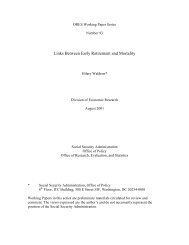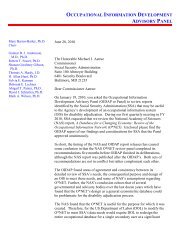Download entire publication - Social Security
Download entire publication - Social Security
Download entire publication - Social Security
You also want an ePaper? Increase the reach of your titles
YUMPU automatically turns print PDFs into web optimized ePapers that Google loves.
on the differences between the occupations SSI recipientshave and those of the nonrecipient populationswith and without disabilities. By understanding thedifferences between the occupations of these groups,policymakers may be able to develop work incentivesand vocational rehabilitation programs that will helpthese individuals return to the work force in a mannerthat will enable them to be self-sufficient. Thismay result in placing these individuals in occupationsknown to provide either immediate earnings or withhigher earnings potential.Previous LiteratureAlthough several previous analyses have focused onthe labor force participation of the SSI and <strong>Social</strong><strong>Security</strong> Disability Insurance (DI) beneficiarypopulations (see, for example, Neumark and Powers(2003/2004); Muller, Scott, and Bye (1996); Autor andDuggan (2003); Hennessey and Muller (1995); Hennessey(1997); Muller (1992)), there have only beena handful of studies on the occupations of recipientswho work (see, for example, Schechter (1999)). 4Most related occupational research has focused onall individuals with disabilities, who generally haveless severe disabilities and greater labor force participationthan the SSI population. Haveman and Wolfe(1990) and Wolfe and Haveman (1990) summarize theresearch of the employment patterns of individualswith disabilities through the mid-1980s, which wascharacterized by declining labor force participationrates. The employment of individuals with disabilitiesappears to be more cyclical than the nondisabledpopulation (Yelin and Katz 1994).The general decline in the employment rates ofindividuals with disabilities over the past few decades,shown by Burkhauser, Houtenville, and Wittenburg(2003), may be expected to translate into a tighterdistribution of occupations for SSI recipients and otherworkers with disabilities. The changes in occupationalrequirements in the occupations of those with disabilitiesmay also affect the occupational distribution (Stapleton,Goodman, and Houtenville 2003). However,Trupin and Yelin (2003) found no consistent trend inchanges in the share of occupations held by those withand without disabilities from 1970 through 2001.Occupation is common as an explanatory variablein regressions of earnings or labor force participation(for example, Muller (1992), Hotchkiss (2004), Ozawaand Yeo (2006)), but it is uncommon as the dependentvariable in the literature on disability, especially on theSSI and DI populations. Most studies consider broadoccupational categories, which mask finer occupationdefinitions. For example, Yelin and Cisternas (1996)used the National Health Interview Survey to showthat 17.2 percent of individuals with disabilities wereemployed as professionals, followed closely by servicejobs at 16.1 percent. They found that the change inoccupation mix between 1970 and 1992 affected thosewith and without disabilities in a similar manner.Their grouping of occupations into nine categoriessheds light on the general type of jobs performed, butlacks detail regarding specific occupations.Stoddard and others (1998) report tabulations of theoccupations of workers with disabilities from McNeil(1993), based on the 1991 Survey of Income and ProgramParticipation (SIPP). They show that four occupations(out of 58) account for 25 percent of occupationsof workers with disabilities—executive and administrative,machine operators, food preparation and service,and sales (retail and personal services). Hale, Hayghe,and McNeil (1998) also use the SIPP and find that individualswith severe disabilities are most likely to be inservice occupations or work as operators, fabricators,and laborers. It is likely, however, that employmentin some occupations (for example, laborers) may be acontributing cause of the disability, and the occupationsof those with disabilities severe enough to receive SSIpayments or DI benefits may be different.Some studies have revealed information on thecharacteristics of the occupations of individuals withdisabilities or the DI beneficiary or SSI recipient populations,but not the occupations themselves. Yelin andTrupin (2003), for instance, found that individuals withdisabilities are less likely to be employed in traditionaloccupations or occupations that are economicallyand psychologically rewarding. The skills required incertain occupations and the level of accommodationmay affect what types of jobs individuals with disabilitiescan perform. “Whether persons with disabilitiesare increasingly relegated to peripheral jobs withinthe growing and declining sectors of the economy orwhether, instead they get the kinds of jobs and theworking conditions they want and in which they andtheir workplaces can succeed” (Yelin and Cisternas1996, 55) is likely more important for those with themost severe disabilities and those with low labor forceattachment (who are more likely to be SSI recipients).Workers with disabilities are more likely to havelower levels of education (Hale, Hayghe, and McNeil1998; Steinmetz 2006). This is especially true of SSIrecipients (DeCesaro and Hemmeter 2008) and maylimit the occupational choices available to them.<strong>Social</strong> <strong>Security</strong> Bulletin • Vol. 69 • No. 3 • 2009 49








